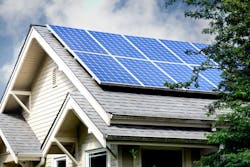Scientists Create the First Transparent Solar Panels
The creation of window-like solar panels could mean a wider rollout and solar energy usage—once scientists are able to maximize the transparent panels’ efficiency. Scientists at Incheon University in South Korea were able to create transparent solar panels made from titanium dioxide and nickel oxide instead of the opaque semiconductor layers in traditional panels, according to Euro News. The opaque panels limit usage to roof and solar farm usage, but new window-like panels may broaden the possibilities for solar energy. Unfortunately, the innovation only works at 2% efficiency compared with traditional panels.
We spoke to solar expert Dr Stuart Irvine, Director of the Centre for Solar Energy Research at Swansea University, about the complications this may pose.
For Irvine, a low rate of efficiency is “the biggest challenge” for a wider rollout.
“The challenge here is, how far can they push the efficiency to actually get a useful amount of electricity out?” he says.
The work completed by the university in South Korea adds to other research being done globally to see how solar energy can be integrated into buildings. Dr Irvine calls the ongoing research “exciting”.
